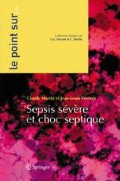Preview
Unable to display preview. Download preview PDF.
Références
Leone M, Bourgoin A, Cambon S et al. (2003) Empirical antimicrobial therapy of septic shock patient: adequacy, and impact on the outcome. Crit Care Med 31: 462–7
Vincent JL, Bihari DJ, Suter PM et al. (1995) The prevalence of Nosocomial Infection in Intensive Care Units in Europe. Results of the European Prevalence in Intensive Care (EPIC) Study. JAMA 274: 639–44
Rello J, Quintana E, Ausina V et al. (1991) Incidence, etiology, and outcome of nosocomial pneumonia in mechanically ventilated patients. Chest 100: 439–44
Torres A, Aznar R, Gatell JP et al. (1990) Incidence, risk, and prognosis factors of nosocomial pneumonia in mechanically ventilated patients. Am Rev Resp Dis 142: 523–8
Fagon JY, Chastre J, Hance AJ et al. (1993) Nosocomial pneumonia in ventilated patient: a cohort study evaluating attributable mortality and hospital stay. Am J Med 94: 281–8
Leone M, Bourgoin A, Giuly E et al. (2002) Influence on outcome of ventilator-associated pneumonia in multiple trauma patients with head trauma treated with selected digestive decontamination. Crit Care Med 30: 1741–6
Papazian L, Thomas P, Garbe L et al. (1995) Bronchoscopic or blind sampling techniques for the diagnosis of ventilator-associated pneumonia. Am J Respir Crit Care Med 152: 1982–91
Chastre J, Fagon JY, Bornet-Lecso M et al. (1995) Evaluation of bronchoscopic techniques for the diagnosis of nosocomial pneumonia. Am J Respir Crit Care Med 152: 231–40
Mimoz O, Bouchet E, Edouard A et al. (1995) Limited usefulness of urinary dipsticks to sceen out catheter-associated bacteriuria in ICU patients. Anaesth Intens Care 23: 706–7
Leone M (2003) Infections urinaires nosocomiales en réanimation. Med Mal Infect, 284s–292s.
Barkhausen J, Stoblen F, Dominguez-Fernandez E, Henseke P, Muller RD (1999) Impact of CT in patients with sepsis of unknown origin. Acta Radiol 40: 552–5
Mimoz O, Rayeh F, Debaene B (2001) Infections liées aux cathéters veineux en réanimation. Physiopathologie, diagnostic, traitement et prévention. Ann Fr Anesth Réanim 20: 520–36
Parrillo JE (1993) Pathogenetic mechanisms of septic shock. N Engl J Med 328: 1471–7
Dellinger RP (2003) Cardiovascular management of septic shock. Crit Care Med 31: 946–55
Tavernier B, Makhotine O, Lebuffe G et al. (1998) Systolic pressure variation as a guide to fluid therapy in patients with sepsis-induced hypotension. Anesthesiology 89: 1313–21
Rivers E, Nguyen B, Havstad S et al. (2001) Early Goal-Directed Therapy Collaborative Group. Early goal-directed therapy in the treatment of severe sepsis and septic shock. N Engl J Med 345: 1368–77
Bernardin G, Hyvernat H, Mattéi M (2001) Place du cathétérisme cardiaque droit et de l’échocardiographie dans la prise en charge du choc septique. Réanimation 10: 183–95
Pinsky MR (2003) Clinical significance of pulmonary artery occlusion pressure. Intensive Care Med 29: 175–8
Gaar KA Jr, Taylor AE, Owens LJ, Guyton AC (1967) Pulmonary capillary pressure and filtration coefficient in the isolated perfused lung. Am J Physiol 213: 910–4
Teboul JL, Besbes M, Andrivet P et al. (1992) A bedside index assessing the reliability of pulmonary occlusion pressure during mechanical ventilation with positive end-expiratory pressure. J Crit Care 7: 22–9
Pinsky MR, Vincent JL, De Smet JM (1991) Estimating left ventricular filling pressure during positive end-expiratory pressure in humans. Am J Resp Dis 143: 25–31
Perret C, Tagan D, Feihl F, Marini JJ (1994) Le cathétérisme droit en soins intensifs. Paris, Eds Arnette
Huemer G, Wolhrab C, Greher M (1998) Transoesophageal echocardiography and volume management in the intensive care unit. Anaesthesia 53(Suppl. 2): 8–10
Clements FM, Harpole DH et al. (1990) Estimation of left ventricular volume and ejection fraction by two-dimensional transoesophageal echocardiography: comparison of short axis imaging and simultaneous radionuclide angiography. Br J Anaesth 1990; 64: 331–6
Jafri SM, Lavine S, Field BE et al. (1990) Left ventricular diastolic function in sepsis. Crit Care Med 18: 709–14
Vincent JL (2000) Need for intensivists in intensive care units. Lancet 356: 695–6
Rights and permissions
Copyright information
© 2005 Springer-Verlag France
About this chapter
Cite this chapter
Léone, M., Garnier, F., Martin, C. (2005). Examens complémentaires. In: Sepsis sévère et choc septique. Le point sur⋯. Springer, Paris. https://doi.org/10.1007/2-287-27496-0_8
Download citation
DOI: https://doi.org/10.1007/2-287-27496-0_8
Publisher Name: Springer, Paris
Print ISBN: 978-2-287-22072-2
Online ISBN: 978-2-287-27496-1
eBook Packages: MedicineMedicine (R0)

